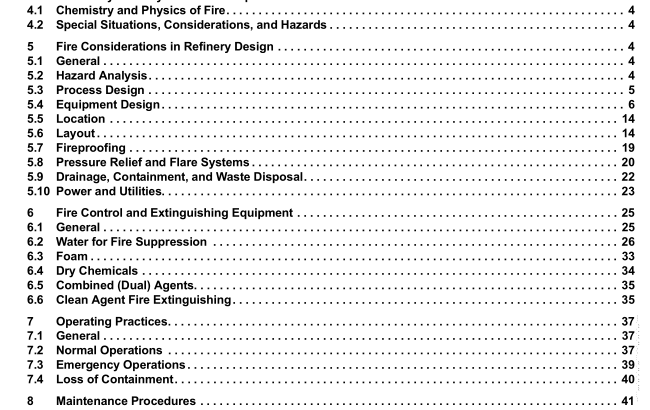API RP 2001:2012 pdf free download.Fire Protection in Refineries
4.1 Chemistry and Physics of Fire
The inherent hazards associated with processing, handling, and/or storage of petroleum products are partly due to the volatility of many of these products. If proper precautions are not followed to prevent the concurrent presence of these volatile components of combustion, there is the possibility of a fire or explosion. This could result in risk of harm to exposed personnel, damage to equipment, and adverse effects on the environment. Personnel involved in refinery fire protection should be familiar with the general combustion principles. Annex A provides more in-depth information on the properties and hazards of petroleum products and the chemistry and physics of fire. This resource can be useful for review or training. Fire prevention and protection measures available to deal with these hazards can be found in other sections of this publication and in cited references.
4.2 Special Situations, Considerations, and Hazards Certain inherent properties of hydrocarbon materials processed and produced in refineries present unique hazards related to hydrocarbon storage. Some of these phenomena (discussed in Annex A) have the potential to cause substantial damage. Some examples are: boilover, slopover, frothover, and boiling liquid expanding vapor explosion (BLEVE). Hazards such as these should be recognized and addressed while designing for fire prevention and planning for emergency response. Operational precautions, such as outlined in this recommended practice, and well-planned emergency response can reduce the likelihood of occurrence and help prevent escalation in the event of an incident.
5 Fire Considerations in Refinery Design
5.1 General This section discusses general design principles for refineries, with emphasis on fire prevention and fire mitigation. This recommended practice is not a design manual. Many of the references cited can provide specific design information. The principles outlined are intended as guides to good engineering practice. The principles described identify certain areas to consider during refinery design for new construction or upgrades and expansions (1.3) to help reduce the possibility of a fire and to mitigate fire damage. Variance from the principles described does not necessarily imply that a refinery is inadequately protected against fire. Safety and fire protection practices should be evaluated within the design philosophy of the specific project involved, on the basis of experience, accepted process safety management practices, normal industry practice, and regulatory requirements.
5.2 Hazard Analysis Preventing and mitigating loss of containment of flammable and combustible materials is an important element of refinery fire protection.
Systematic hazard analysis with implementation of the findings can help a refinery avoid major releases of process materials and reduce the risk of potential fires. These activities can also help the facility implement corporate Management of Process Hazards programs and satisfy regulatory requirements. Regulatory examples in the United States are OSHA 1910.119, Process Safety Management of Highly Hazardous Chemicals (OSHA PSM) and U.S. Environmental Protection Agency (EPA) Risk Management Program Rule (EPA RMP). A fire hazard analysis (FHA), which is different from a preliminary hazard analysis (PHA), can help more broadly define fire protection needs.
NOTE In-depth FHA discussions relevant to refineries can be found in some bibliography references such as AICHE-CCPS’s Guidelines for Fire Protection in Chemical, Petrochemical and Hydrocarbon Processing Facilities. However, many published FHA protocols focus on structural fires and are less relevant to process facilities.
The use of hazard analysis (PHA) during process design, site selection, refinery layout, equipment selection, and civil and structural design will aid in the identification of potential hazards that might result in fires. Preventive and mitigative safety elements can then be considered early in the conceptual stages and continue throughout all stages of process design for new construction, upgrades, and expansions. The hazard analysis should include input from research and development personnel, designers, and refinery management. API RP 2001 pdf download.API RP 2001:2012 pdf free download
